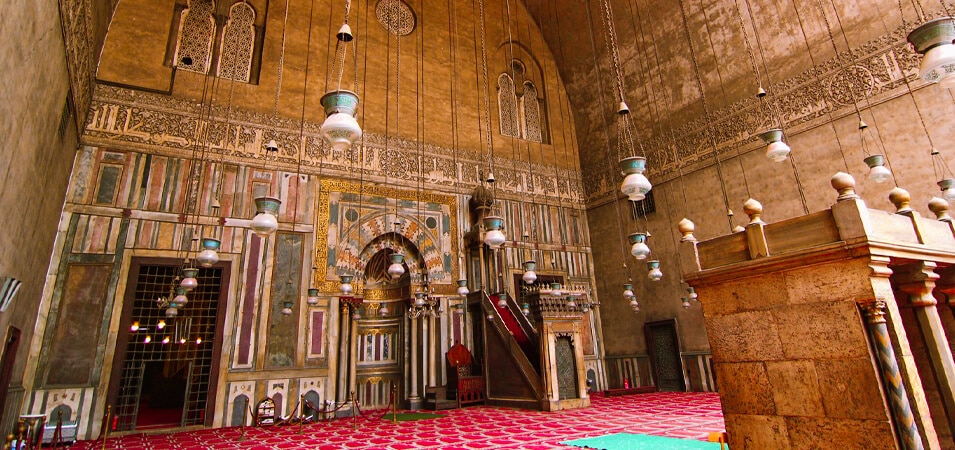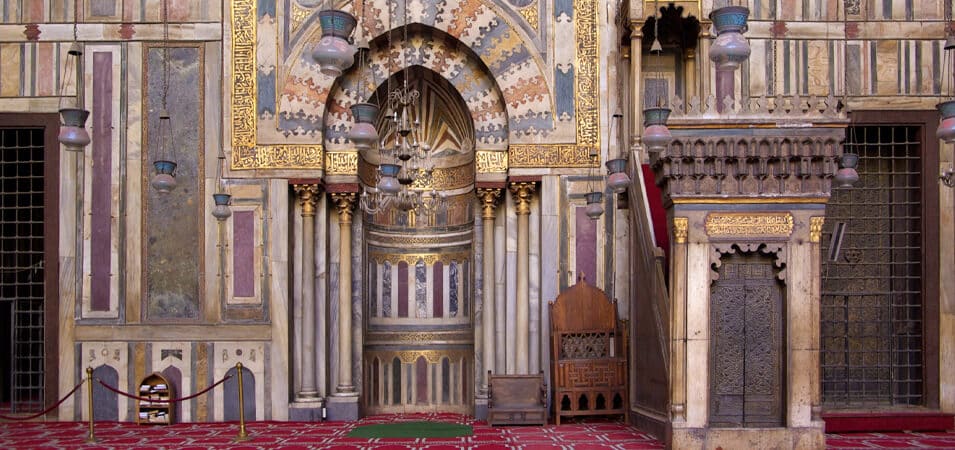The Sultan Hassan Mosque, a marvel of Islamic architecture, is a testament to Egypt’s rich history and cultural heritage. Situated in the heart of Cairo, this historic mosque is a captivating symbol of the Mamluk era. Its towering minarets and intricate façade beckon visitors worldwide to explore its grandeur. In this blog, we journeyed to unravel the stories, mysteries, and beauty that define the Sultan Hassan Mosque. From its inception to its enduring legacy, this introduction sets the stage for a deeper exploration of the mosque’s history, significance, and architectural wonders that await us.
Discover the charm of Islamic Cairo, a district steeped in history.
History and Significance of the Sultan Hassan Mosque
The history and significance of the Sultan Hassan Mosque intertwine with the tapestry of Egypt’s past, creating a narrative that spans centuries. Constructed in the 14th century during the Mamluk Sultanate, this architectural masterpiece has witnessed the rise and fall of dynasties, the ebb and flow of empires, and the evolution of Islamic culture in Egypt. Its builder, Sultan Hassan, intended it to be a place of worship and a symbol of his power and authority. Over time, the mosque has become an enduring symbol of Islamic art and architecture, showcasing the intricate beauty of the Mamluk period. Beyond its architectural brilliance, the mosque has played a pivotal role in Cairo’s cultural and religious landscape, making it a site of immense historical importance. In this section, we delve into the fascinating history and multifaceted significance of the Sultan Hassan Mosque, shedding light on its role in shaping Egypt’s past and present.
Experience A Day in the Ancient City of Luxor.
Architectural features of the Sultan Hassan Mosque

The architectural features of the Sultan Hassan Mosque are a captivating display of Islamic architectural ingenuity. The mosque’s exterior is characterized by its imposing scale, with soaring minarets that pierce the sky and a facade adorned with intricate geometric patterns and ornate calligraphy. As one steps inside, the vast courtyard opens up, surrounded by elegant arcades and stately columns, creating a sense of grandeur and serenity. The central prayer hall, towering pointed arches and soaring dome, is a masterpiece of architectural symmetry and precision. It’s adorned with breathtaking stained glass windows and exquisite marble work, adding to its ethereal beauty. In this section, we embark on a visual journey to explore the mesmerizing architectural features of the Sultan Hassan Mosque, celebrating the artistry and craftsmanship that make it a jewel of Islamic architecture.
Step back to the Ancient City of Memphis, an archaeological treasure.
Unique design elements of the Sultan Hassan Mosque
The Sultan Hassan Mosque boasts an array of unique design elements that set it apart as a true architectural gem. One of its standout features is the clever use of colossal stone piers instead of traditional columns in the central prayer hall, creating an open, unobstructed space that’s awe-inspiring and functional. The exquisite detailing in the mosque’s mihrab, a niche indicating the direction of Mecca, showcases a mastery of Islamic geometric patterns and calligraphy, with inscriptions from the Quran adorning its surface. Additionally, the mosque’s incorporation of solar phenomena in its design is unique; during specific times of the day, sunlight filters through openings in the walls, casting patterns that mark prayer times. These distinctive design elements and many others combine to make the Sultan Hassan Mosque a remarkable architectural wonder that continues to captivate visitors with its innovation and beauty.
Immerse yourself in the enchanting allure of Cairo by Night.
The interior of the Sultan Hassan Mosque
Stepping into the interior of the Sultan Hassan Mosque is like entering a world of awe-inspiring beauty and spirituality. The grandeur of the mosque’s architecture seamlessly transitions to its interior, where visitors are greeted with an expansive central courtyard adorned with intricate marble floors and surrounded by towering arcades. The focal point becomes the stunning main prayer hall as one moves further inside. The soaring pointed arches, gracefully adorned with geometric patterns, lead the eye to a magnificent dome that seems to touch the heavens. The walls are adorned with intricate calligraphy and stained glass windows that filter colorful light into the hall, creating a serene and spiritual ambiance. The mihrab, which points toward Mecca, is a masterpiece of Islamic artistry, featuring intricate geometric designs and Quranic inscriptions. The interior of the Sultan Hassan Mosque is a testament to the craftsmanship and devotion that went into its creation, making it a place of profound significance for both art and faith.
The cultural and religious importance of the Sultan Hassan Mosque

The cultural and religious importance of the Sultan Hassan Mosque transcends time and space, leaving an indelible mark on both Egypt’s heritage and the Islamic world. From a spiritual perspective, the mosque has served as a center of worship, echoing the prayers and devotion of countless generations of Muslims. Its central role in the religious life of Cairo has made it a symbol of spiritual significance and a place for Muslims to gather for congregational prayers and reflection.
Culturally, the mosque is a testament to the Mamluk period’s architectural and artistic achievements, showcasing its exquisite craftsmanship. Its intricate geometric designs, calligraphic inscriptions, and the use of innovative architectural features have made it a source of inspiration for artists, architects, and scholars throughout history.
Beyond these aspects, the mosque has played a vital role in shaping the cultural identity of Cairo. Its grandeur and historical importance have made it a focal point for cultural events, academic study and a place of reverence for locals and visitors. In this section, we explore the deep-seated cultural and religious significance of the Sultan Hassan Mosque, shedding light on its enduring importance in the hearts and minds of people worldwide.
Climb to the top of Bab Zuweila for panoramic views of Cairo’s skyline.
Visiting the Sultan Hassan Mosque: Tips and recommendations
Visiting the Sultan Hassan Mosque is a journey through history and artistry; to make the most of your experience, it’s essential to be well-prepared. Here are some valuable tips and recommendations for your visit:
- Respect the Dress Code: When entering the mosque, dress modestly. Both men and women should cover their shoulders, arms, and legs. Women are typically required to wear a headscarf.
- Mind Prayer Times: The mosque may be closed to tourists during prayer times, so it’s good to check the prayer schedule in advance to plan your visit accordingly.
- Guided Tours: Consider taking a guided tour of the mosque. Knowledgeable guides can provide historical context and insights into the architectural marvels within.
- Photography is usually allowed, but be respectful and avoid taking pictures during prayer times or of worshippers without their permission.
- Footwear: You must remove your shoes before entering the prayer hall. Bring socks or wear easily removable shoes for convenience.
- Respectful Behavior: Maintain a quiet and respectful demeanor within the mosque. Avoid loud conversations and be mindful of the religious significance of the place.
- Explore the Surroundings: The Sultan Hassan Mosque is situated in a historically rich area of Cairo. Take the time to explore nearby attractions, such as the Citadel of Saladin and the historic Khan el-Khalili market.
- Check Opening Hours: Confirm the mosque’s opening hours before your visit. These hours can vary, so it’s best to double-check to ensure you don’t arrive when it’s closed to the public.
- Learn About Its History: Gain a deeper appreciation for the mosque by learning about its history and significance in advance. Understanding its context will enhance your experience.
- Respectful Departure: When leaving the mosque, do so quietly and respectfully. Remember that it remains a place of worship for many.
Explore our Tours:
- Islamic Cairo Tour To Famous Mosques in Cairo
- Day Tour To Coptic and Islamic Cairo
- 3 Day Tour To Cairo
- 4 Day Cairo Tour Package
- Day Tour To Egyptian Museum and Coptic and Islamic Cairo
- Day Tour To Egyptian Museum and Citadel and Old Cairo
Interesting facts about the Sultan Hassan Mosque
The Sultan Hassan Mosque is a marvel of architecture and a repository of fascinating historical and cultural facts. Here are some intriguing details about this iconic mosque:
- Record-Breaking Minarets: The mosque’s twin minarets, which rise to over 80 meters (260 feet), were the tallest in the world when built in the 14th century.
- Intricate Mathematical Precision: The mosque’s architecture is known for its meticulous use of geometric patterns and mathematical precision, reflecting the advanced mathematical knowledge of the Mamluk era.
- Solar Alignment: The mosque is designed so that the sun’s rays align with specific points in the prayer hall, serving as natural time indicators for daily prayers.
- Multi-Functional Complex: Besides being a place of worship, the Sultan Hassan Mosque also served as a madrasa (Islamic school) and a mausoleum for Sultan Hassan and his family.
- Construction Challenges: The mosque’s construction took about seven years, a remarkable feat considering the technology and resources available.
- Rich Decoration: The mosque’s interior is adorned with intricate stucco work, ornate marble inlays, and stunning stained glass windows, showcasing the luxury and craftsmanship of the Mamluk period.
- Restoration Efforts: Over the centuries, the mosque has undergone multiple restorations to preserve its historical and architectural significance.
- Historical Significance: The Sultan Hassan Mosque has played a role in various historical events, including the French invasion of Egypt in the late 18th century when it was used as a military hospital.
- Tourist Attraction: Today, the mosque attracts tourists and history enthusiasts worldwide, making it one of Cairo’s most visited landmarks.
- Film and TV: The mosque has appeared in several movies and television series, further cementing its status as an iconic cultural symbol.
These exciting facts add depth to the story of the Sultan Hassan Mosque, making it not just a place of architectural beauty but a treasure trove of historical and cultural significance.
Sultan Hassan Mosque in popular culture

The Sultan Hassan Mosque has left an indelible mark on popular culture, appearing in various media and art forms, showcasing its enduring allure. It has often been depicted in literature, film, and television as a backdrop for stories set in the heart of Cairo. In literature, the mosque has inspired numerous local and international writers who have woven its grandeur into their narratives.
On the silver screen, the Sultan Hassan Mosque has been featured in films that capture the mystique and allure of Cairo, becoming an iconic cinematic symbol of the city’s rich history and culture. Likewise, in television series, it has made cameo appearances, lending authenticity to scenes set in Cairo’s historical past.
Moreover, the mosque’s stunning architecture and historical significance have also made it a popular subject for artists and photographers, who aim to capture its intricate beauty from various angles and perspectives.
Overall, the Sultan Hassan Mosque’s presence in popular culture reinforces its status as a cultural and architectural treasure, ensuring its legacy resonates with audiences worldwide, transcending time and borders.
Conclusion: The enduring legacy of the Sultan Hassan Mosque
In conclusion, the Sultan Hassan Mosque is a timeless testament to the grandeur of Islamic architecture and the enduring legacy of Egypt’s history and culture. From its majestic minarets that reach for the heavens to its intricate geometric designs and spiritual significance, the mosque continues to captivate the hearts and minds of people from all walks of life.
Through centuries, the mosque has weathered the sands of time, witnessing the rise and fall of dynasties and the evolution of Cairo as a vibrant metropolis. Its enduring legacy extends beyond its architectural splendor; it embodies the spirit of a bygone era, a reminder of the remarkable achievements of the Mamluk period.
Today, the Sultan Hassan Mosque remains a source of inspiration for architects, historians, artists, and visitors drawn to its beauty and historical significance. It is a place of worship, a symbol of cultural pride, and a living testament to the rich tapestry of Egypt’s past.
As we reflect on the Sultan Hassan Mosque’s enduring legacy, we are reminded of the profound impact of human ingenuity and artistic expression on the world. It is a beacon of history, culture, and spirituality, casting its light across generations and continuing to enrich our understanding of the past and our appreciation for the beauty that endures in the present.





